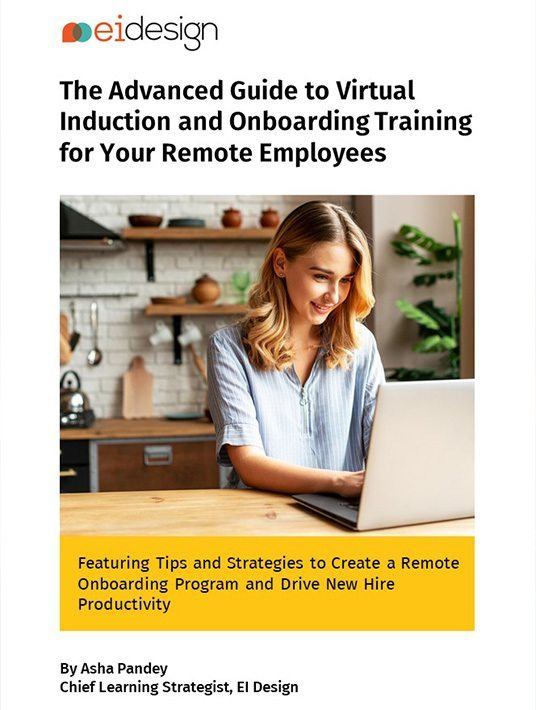Being A Remote Worker In The Time Of The Pandemic
Virtual induction and onboarding training are vital to the success of your team of remote employees. Did you know that in the first 45 days of joining a new organization, 1 in 5 employees determine if they should drop out?

Recruitment is a high-priced and time-consuming procedure. After the right candidates have been selected for the job, specific measures need to be put in place to induct and onboard them as quickly and efficiently as possible. This evidently upholds the necessity for a well-structured and equally well-executed corporate induction and onboarding training program to make sure that new employees are not disenchanted. Notably, it should help enhance the positive image of the organization.
The conventional face-to-face method to provide induction and onboarding programs is typically the method most organizations opt for. This is highly impactful, and the human touch goes a long way in aiding new employees to learn the organization culture, its value proposition, and how they can contribute effectively.
However, given that COVID-19 has led to changed workplace dynamics, organizations must consider moving the face-to-face induction and onboarding programs to a virtual mode.
In this eBook, The Advanced Guide To Virtual Induction And Onboarding Training For Your Remote Employees:
- I begin by outlining the aspects, challenges, and options available while moving your ILT induction and onboarding program to a virtual mode.
- I list tips and best practices that can be used for virtual induction and onboarding training.
- Next, I show you how blended learning helps promote the organizational culture.
- I explain the concept of time-to-productivity and strategies and tips that can shorten time-to-productivity through employee onboarding training.
- I address how you can leverage mobile learning and implement learning strategies that can be used to create effective virtual induction and onboarding training programs.
- I wrap up with a case study on transitioning a face-to-face induction and onboarding program to a fully virtual (blended 2.0) mode.
More About The eBook: The Advanced Guide To Virtual Induction And Onboarding Training For Your Remote Employees
I have designed the eBook The Advanced Guide To Virtual Induction And Onboarding Training For Your Remote Employees into 6 sections as shown here:
1. How To Choose The Right Approach For Delivering Virtual Induction And Onboarding Training
The first section of this eBook presents the aspects you need to take into consideration as you embrace a virtual induction and onboarding program. It provides a list of the challenges that are associated with inducting and onboarding remote employees without human touchpoints. There is also an outline of two different approaches that you should be aware of if you would like to move your ILT induction and onboarding program to a virtual mode. Finally, this section explains the reasons why organizations are attracted to blended induction and onboarding programs and aim to use them for the entire spectrum of their training needs.
2. What Tips And Best Practices Can Be Used For Virtual Induction And Onboarding Training
Despite the fact that we are against a global pandemic, the need to implement a strong induction and onboarding program for new employees remains strong. They could be offered the option to take induction and onboarding sessions from their home, or in a half-full workspace, but the program should live up to their expectations. This section is dedicated to various tips and best practices that can be used to onboard new employees remotely in the midst of COVID-19.
3. How To Promote Organizational Culture In Virtual Induction And Onboarding Training
Conventionally, many organizations were using centralized corporate training centers in which they practiced Instructor-Led Induction Training (ILT) in order to onboard new employees. This section explains why, with these new workplace dynamics, blended learning is possibly the most efficient approach to such training and can assist the strengthening of the cultural norms that an organization expects from these new entrants.
4. How To Shorten New Hire Time-To-Productivity With Virtual Induction And Onboarding Training
The following section explains how knowledge transfer and skills enhancement are still a key focus area of employee onboarding training, and time-to-productivity is one metric that accurately describes the success of such programs. The section goes on to further illustrate strategies and tips that can shorten time-to-productivity through employee onboarding training.
5. How Mobile Learning Can Be Used To Create Effective Virtual Induction And Onboarding Training Programs
The final section of the eBook highlights why it is vital to include mLearning, or mobile learning, in your virtual induction and onboarding training strategy since the majority of the new employees will be working from home.
It also describes how mobile learning for induction and onboarding training can benefit both learners as well as the organization. It also includes learning strategies that can be used to create effective virtual induction and onboarding training programs.
6. Case Study: On Transition Of A Face-To-Face Induction And Onboarding Program To A Virtual (Blended 2.0) Mode
Induction and onboarding are ongoing and recurrent activities for an organization on a growth path. This section showcases a case study on how we successfully transformed our predominantly classroom-based induction and onboarding program to a blended 2.0 mode.
In Conclusion
Even if your team is remote, you should offer your new employees the chance to have the best onboarding experience. Do download my eBook The Advanced Guide To Virtual Induction And Onboarding Training For Your Remote Employees and enjoy reading!
If you want support on how to transition from a face-to-face induction and onboarding program to a virtual mode effectively, do contact me or leave a comment below.







